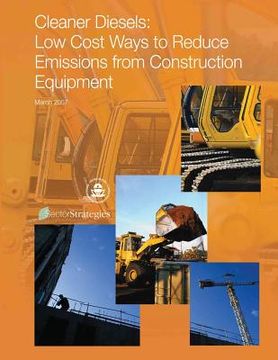Share
Cleaner Diesels: Low Cost Ways to Reduce Emissions from Construction Equipment (in English)
Agency, U. S. Environmental Protection (Author)
·
Createspace Independent Publishing Platform
· Paperback
Cleaner Diesels: Low Cost Ways to Reduce Emissions from Construction Equipment (in English) - Agency, U. S. Environmental Protection
$ 11.99
$ 14.99
You save: $ 3.00
Choose the list to add your product or create one New List
✓ Product added successfully to the Wishlist.
Go to My WishlistsIt will be shipped from our warehouse between
Tuesday, July 09 and
Wednesday, July 10.
You will receive it anywhere in United States between 1 and 3 business days after shipment.
Synopsis "Cleaner Diesels: Low Cost Ways to Reduce Emissions from Construction Equipment (in English)"
Air pollution from diesel emissions is a public health concern that reaches every part of the country. There are two main pollutants of concern in diesel exhaust that affect human health: nitrogen oxide (NOx) and particulate matter (PM). NOx is one of the main ingredients in the formation of ground-level ozone, which can trigger respiratory problems. Ozone can aggravate asthma and other respiratory diseases, leading to more visits to the emergency room and increased hospitalizations. Ozone can inflame and damage the lining of the lungs. This may lead to permanent changes in lung tissue and to irreversible reductions in lung function if the inflammation occurs repeatedly over a long time period. PM has been associated with an increased risk of premature mortality, hospital admissions for heart and lung disease, and increased respiratory symptoms. Long-term exposure to diesel exhaust is likely to pose a lung cancer hazard. In addition, PM, NOx, and ozone adversely affect the environment in various ways including visibility impairment, crop damage, and acid rain. The construction sector is a significant contributor to these emissions, creating 32 percent of all mobile source NOx emissions and 37 percent of PM emissions. While stringent new emissions standards are scheduled to significantly reduce emissions from new nonroad equipment starting in 2008, much of the equipment in the current nonroad diesel fleet will continue to operate for many years to come. Therefore, reducing emissions from the existing legacy construction equipment fleet is an important component of EPA's emissions control strategy. The construction sector is highly diverse and is made up predominately of smaller companies. Approximately 92 percent of construction companies have 20 or fewer employees. They tend to be low-margin businesses, with much of their business value accumulated in their capital equipment. Consequently, construction companies resist modifications that they believe will restrict their equipment's operability or increase maintenance. Small companies may not have the ability to spend significant resources to reduce emissions from their equipment. The purpose of this research project was to study and identify low cost ways to reduce emissions from nonroad construction equipment. The report documents the costs and benefits of a number of these strategies - actions that may be taken by small companies (and medium or larger ones as well) in the construction sector to reduce their emissions.
- 0% (0)
- 0% (0)
- 0% (0)
- 0% (0)
- 0% (0)
All books in our catalog are Original.
The book is written in English.
The binding of this edition is Paperback.
✓ Producto agregado correctamente al carro, Ir a Pagar.

